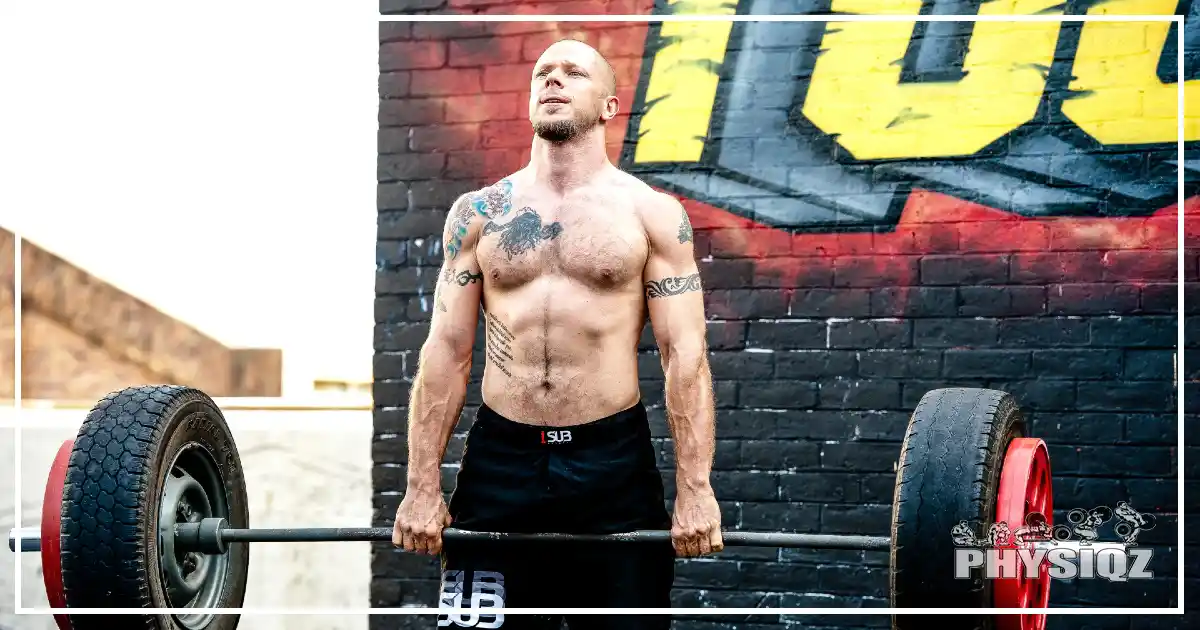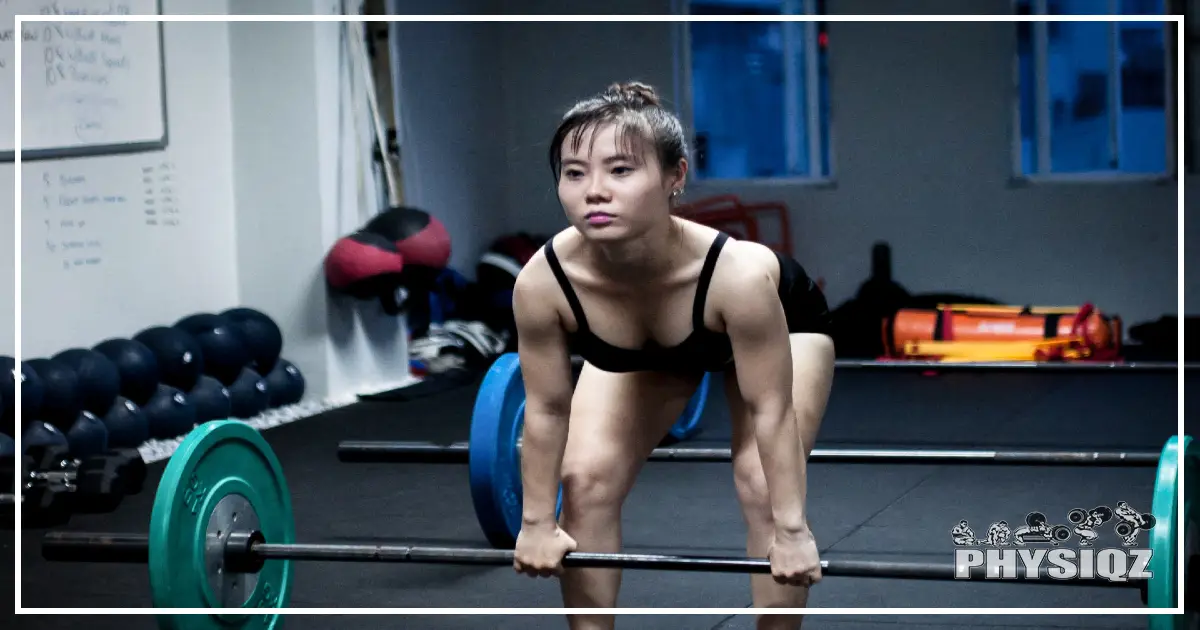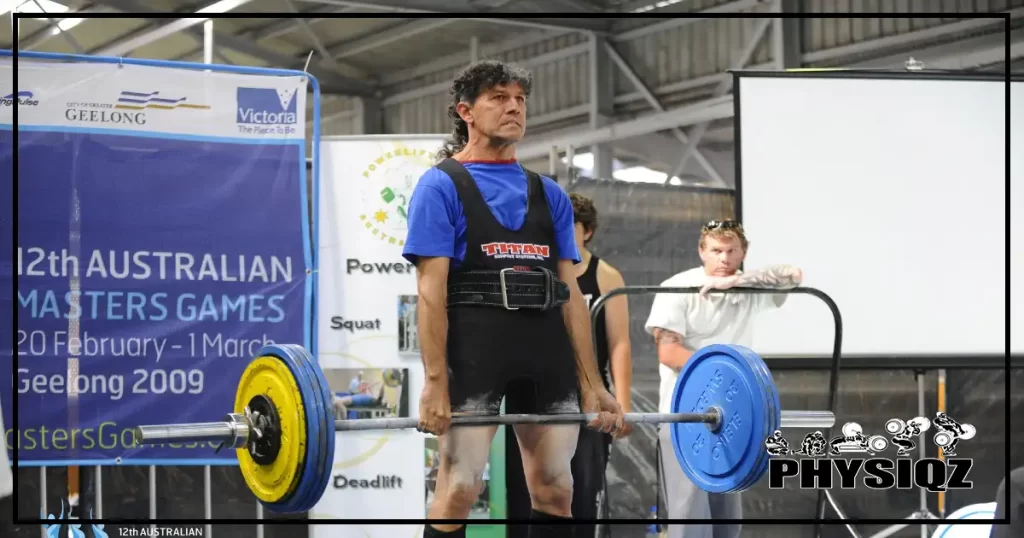
The debate about which is better between touch-and-go deadlifts and reset deadlifts has been raging in fitness circles for years.1 However, the answer isn’t as clear-cut as one may think, and resets can actually be better depending on the lifter’s goal.
For example, reset deadlifts are a better style for lifters when targeting strength and want to perfect their deadlifting skills. But this doesn’t mean that dead stop deadlifts are better than the touch-and-go technique.
Both styles are essential and have advantages for some lifters depending on the lifters’ specific goals and intended outcomes but we’re here to demystify the debate for good.
Make sure to choose the right method: touch and go deadlifts compared with reset deadlifts (and dead stop deadlifts) is easy if you know the golden rule below.
What is a Touch & Go Deadlift & How to Perform It?
A touch-and-go deadlift is a style where the barbell doesn’t rest on the floor during reps. The bar just lightly grazes the floor before moving on to the next repetition of the deadlift. Just as the name suggests, there is no reset or pause between reps. The lifter simply picks the weight up, lowers it to the floor, and then repeats.
To set things straight, a touch-and-go deadlift is not a bounce, as many fitness enthusiasts claim. When using this technique, the lifter maintains tension and fully controls the bar as it goes down. The bar touches the floor, and the lifter doesn’t release the weight before continuing to the next rep.
Here’s how to perform a touch-and-go deadlift with good form in five steps:
- Stepping up to the bar: The first is to walk to the bar and stand with their mid-feet under the bar but some lifters prefer the bar to touch their shins. The weightlifter’s feet must be apart at about shoulder width.
- Grabbing the bar: After positioning the feet, it’s time to push the butt back while hinging at the hip. This position initiates a bend at the waist, and the weightlifter can now grab the barbell with an overhand grip.
- Bending the knees: Safety is paramount to novices and professional powerlifters when performing deadlifts. In this regard, the barbell must be closer to the body when initiating the first rep. The lifter needs to bend their knees forward until the bar just touches their shins. In addition, they need to ensure that the bar doesn’t roll from the midfoot.
- Lifting the chest: Lifting the chest straightens the back, thereby setting the lats and engaging the core in readiness to lift the weight. The powerlifter needs to maintain their position by ensuring the bar is over their midfoot and touching their shins.
- Pulling the weight up: To get the bar off the floor, the lifter needs to take a big breath into the brace, tighten the chest, and stand up with the weight until the hips extend fully and the knees lock simultaneously. During the concentric phase, the bar should stay close to the body when lifting it off the ground. In addition, the lifter should avoid leaning back when the weight is at the top to avoid back rounding and injuries in weightlifting.2
- Lowering while controlling the weight: Once at the top, it’s time to unlock the hips and knees to return the weight to the floor. The lifter needs to push their hips back while keeping the legs straight and lowering the weight relatively slowly. As weightlifters lower the bar, they need to keep the weight under control. They need to maintain tension and position by hinging at the hips and engaging the core. Immediately after the bar passes below the knees, the bodybuilder should bend the legs. The bar will then return to its original position – above the midfoot. Once the bar touches the floor, start lifting it for the next rep. The bar should not be allowed to completely stop on the floor.
- Repeat steps 6 and 7 until the set is done.
This way, the touch-and-go style successfully achieves the set goals.
The control of the eccentric phase subjects the muscles to more tension necessary for growth. It also sets a momentum to allow for more reps, giving room for more time under tension. This to-go technique is ideal for optimal performance from 6 reps upwards.
However, if the lifter lets the bar bounce off the floor and continues with the second rep, that constitutes “cheating”, or at minimum, it’s leaving gains on the table.
The Debate on Touch & Go Deadlifts vs Reset Deadlifts
The debate on touch and go vs reset deadlifts has been going on for decades within the body-building community, and it’s not showing any signs of slowing down. And with so many contradicting views on the internet, knowing which deadlifting technique is better can be a daunting task.
But it doesn’t have to be.
Professional lifters have weighed in on both sides of this debate. Some say that touch-and-go deadlifts are better because they allow bodybuilders to lift more weight than reset deadlifts. Others say resetting at the bottom of each rep is the better option because it allows a lifter to build more strength and perfect technique.
The pro-reset lifters assert that a “dead” lift implies lifting dead weight, and it should always start from a full stop. They believe that to-go deadlifts are cheats because of the “bouncing” effect on the floor.
And there are plenty of people who fall somewhere in between the two techniques, too.
Well, both styles of deadlifting have their pros. When deciding which style is right for them, weightlifters should consider their fitness goals – whether strength training or muscle building.3
The benefits of one style do not negate those of the other. The truth is, both styles are very practical if done correctly. This holds especially true for newcomers who are on programs like Starting Strength.
Benefits of Touch-&-Go Deadlifts
Internet trolls and professional lifters who regard to-go deadlifts as bounced reps or cheating miss a whole pack of benefits. The truth of the matter is that touch-and-go deadlifts involve controlling the weight on the eccentric phase and maintaining a firm grip on the bar.

Source: tacofleur on Pixabay.com4
Thus, the ridiculous claims that to-go deadlifts constitute cheating are false. When done in the right way, touch-and-go deadlifts have several advantages, including:
- Benefit Number One: Stretch Reflex. To-go deadlifts have an eccentric range of motion since the lifter controls the weight when lowering the bar. The lowering weight helps the lifter build tension and engage stretch reflex. As a result, the momentum arising from the body tension in the eccentric phase makes successive reps pretty easy. Also, the stretch reflex is important because it helps to prevent injuries to muscles and tendons when lifting weights.
- Benefit Number Two: Build Explosive Power. The eccentric portion of subsequent reps generates more explosive power from the stretch reflex. As the bar touches the floor, the body releases the energy to help lift the bar again in explosive deadlifts. Consequently, power building enhances the ability to do more high-volume deadlifts and achieve more 1 rep max.
- Benefit Number Three: Get a Tighter Grip. One of the outstanding advantages of a to-go deadlift is the ability to maintain grip strength. Since the weight doesn’t unload on the floor, the lifter must maintain a tight grip on the bar to lift the weight with form. A firm grip will help in lifting more weight, which will lead to more strength and muscle building.
- Benefit Number Four: Build More Muscle. A touch-and-go deadlift encompasses the eccentric (lowering) and concentric (pulling) phases, thus training both sides of the rep for tension. As a result, muscles remain under tension for an extended period, which promotes hypertrophy. And since the touch-and-go style allows for high volume deadlifts and more weight, there are high chances of building more muscle.5
- Benefit Number Five: Stay Tight. A to-go deadlift doesn’t allow for relaxation or a complete stop on the floor. Instead, the momentum forces the lifter to stay tight throughout the eccentric and concentric phases. Staying tight for the whole set reduces the chances of an injury and makes successive reps pretty easier. However, bouncing the bar off the ground or changing position during reps can significantly increase the risk of injuries.
- Benefit Number Six: It’s An Overload Technique. With touch-and-go, it’s possible to perform more reps with the same weight size compared with full-stop deadlifts. This is because the stretch reflex provides some aid at the bottom, making subsequent reps quite easier.
How Does a Full Stop or Reset Deadlift Differ?
A reset deadlift differs from a touch-and-go deadlift in that it’s a style where the barbell comes to a complete stop, and its weight is completely unloaded onto the ground after a single rep.
As its name implies, a stop or reset deadlift has a “full stop” or pause between reps. Each rep has its own setup, and there is room to modify it from the previous one. This gives the body and mind a chance to prepare to lift the weight after every rep.

Source: PublicDomainPictures on Pixabay.com6
Full-stop deadlifts are also different from to-go deadlifts in form. A reset deadlift helps develop more strength on the quads and spinal erectors because the weight does not go through an eccentric phase. This aspect carries more weight for those in powerlifting competitions, particularly those focused on lifting the heaviest weight in a single rep.
The strengthening of spine erectors and the ability to correct positioning inconsistencies help minimize postural rounding.
Upsides to Full Stop or Reset Deadlifts
Although touch-and-go deadlifts are beneficial in many ways, there are situations when reset deadlifts are actually better. Here are some of the main benefits of reset deadlifts:
- Benefit number one: Increased Strength. Coming to a full stop after every stop places more pressure on the quads and spinal muscles to develop the sufficient strength needed to lift the weight off the floor. And since each rep places strength demands on the muscles, this deadlifting style is ideal for 1 rep max. Therefore, if you’re following a strength-building regimen like the Wendler 5/3/1 workout, focusing more on reset deadlifts during training sessions is recommended.
- Benefit number two: It’s Sport-Specific for Powerlifting. When it comes to competitive powerlifting, full-stop deadlifts are the better option for training. Essentially, the target of competitive powerlifting is to lift the greatest weight in one rep. As such, it is prudent to train deadlifting from a dead stop. Doing so will help develop the strength critical for lifting the weight off the ground without the help of eccentric tension. Programs tailored for powerlifting, such as nSuns 531, replicate competition conditions and enhance the likelihood of success in competitions.
- Benefit number three: Each Rep will be more consistent. With full-stop deadlifts, there is the complete emptying of barbell weight on the ground and resetting after every rep. The absence of an eccentric in the bottom range of motion in reset deadlifts necessitates strength training to get the bar back up. Thus, there is consistency in strength building with every rep.
- Benefit number four: Allows for the perfection of set-up technique. The pause between reps in reset deadlifting allows the lifter to adjust the set-up and correct any inconsistencies. This ensures that the body and the barbell are in the correct position before pulling the weight. Consistently adjusting the setup technique with each rep reduces inconsistencies in the bottom position, progressively perfecting the setup.
Are Touch-&-Go Deadlifts Easier?
Sometimes there is confusion on whether touch and go deadlifts are easier than reset deadlifts. Well, the touch-and-go deadlift has dead weight only in the first rep.
After that, the eccentric and concentric establish momentum on the bar, and the successive reps are pretty much a little easier in a sense, but the constant tension is also more taxing. The momentum from stretch flex boosts the lifts, and that’s why it’s possible to do more reps lifting the same weight compared with stop deadlifts.
Which is Better for Strength? Touch-&-Go Deadlifts or Full Stop (Reset)
When it comes to strength building, full stop or complete stop deadlifts are better. This technique helps lifters build more strength in the bottom range of motion because reps don’t get any assistance from eccentric momentum. The goal of reset deadlifts is to help lifters build more strength. Each rep trains the core muscles and spine erectors to develop the strength necessary for lifting the barbell off the floor.7 Thus, full-stop deadlifts are specific to the demands of the powerlifting sport.
Better still, this style helps competitive powerlifters develop the strength they need to achieve high 1 rep max. As such, powerlifters should do less and less touch and go as competition approaches and focus on resets. After all, competitive powerlifters pull from a complete stop during the actual competition.
To Build Muscle, Should I Do Touch & Go or Reset Deadlifts?
Due to the constant tension, touch-and-go deadlifts are better for building muscles. This style has both eccentric and concentric phases that subject muscles under tension for the whole rep. The double time under tension and the implementation of the stretch reflex act as catalysts to trigger hypertrophy. What’s more, touch-and-go deadlifts allow for more reps and heavy weight, increasing the chances of building more muscles.
However, it is vital to perform a touch and go the right way to realize the benefit of muscle building. Dropping the weight while deadlifting and bouncing it off the floor is wrong because the lifter releases all the weight and loses control of the eccentric.
There’s Merrit to Both: Touch & Go Deadlifts & Reset Deadlifts
Touch-and-go and reset deadlifts each have their advantages, suitable for both beginner lifters and experienced powerlifters alike. One style is not the opposite of the other, but each has its place in the deadlift. Touch and go style is a better option if aiming to build muscle and develop explosive power.
But reset deadlifts are better if a lifter wants to develop more strength and perfect the deadlifting technique. Combining touch-and-go with occasional reset deadlifts can be advantageous for both newcomers and experienced weightlifters, leading to superior maximal strength gains and muscle enhancement.
In summary, both go and stop styles are helpful in deadlifting. Touch and go deadlifts are essential for hypertrophy, while reset deadlifts are beneficial in building strength.
Frequently Asked Questions
High Rep Deadlifts or Low Rep Deadlifts? How Many Reps for Deadlifts?
Touch and go is ideal for a lifter doing high rep deadlifts (8 reps or more) to stimulate hypertrophy. And according to research, muscle growth is one of the main outcomes of resistance training exercises. On the other hand, the full stop technique is perfect for a powerlifter doing low rep deadlifts (5-6 reps) with heavy weight for the purpose of building strength versus a touch-and-go deadlift for muscle growth.
References
1tacofleur. “Free Image on Pixabay – Deadlift, Dead Lift, Weight.” Pixabay, 10 February 2017. Accessed 6 April 2023 <https://pixabay.com/photos/deadlift-dead-lift-weight-2054919/>
2Bengtsson, V., Berglund, L., & Aasa, U. (2018, July 17). Narrative review of injuries in powerlifting with special reference to their association to the squat, bench press and deadlift. NCBI. Retrieved July 18, 2022, from <https://www.ncbi.nlm.nih.gov/pmc/articles/PMC6059276/>
3Schellenberg, F., Taylor, W. R., & Lorenzetti, S. (2017, July 17). Towards evidence based strength training: a comparison of muscle forces during deadlifts, goodmornings and split squats. NCBI. Retrieved July 18, 2022, from <https://www.ncbi.nlm.nih.gov/pmc/articles/PMC5513080/>
4tacofleur. “Free Image on Pixabay – Deadlift, Dead Lift, Weightlifting.” Pixabay, 10 June 2017. Accessed 6 April 2023 <https://pixabay.com/photos/deadlift-dead-lift-weightlifting-2386565/>
5Whittal, M. C., Zwambag, D. P., Vanderheyden, L. W., McKie, G. L., Hazell, T. J., & Gregory, D. E. (2020, September 22). High Load With Lower Repetitions vs. Low Load With Higher Repetitions: The Impact on Asymmetry in Weight Distribution During Deadlifting. NCBI. Retrieved July 18, 2022, from <https://www.ncbi.nlm.nih.gov/pmc/articles/PMC7739658/>
6PublicDomainPictures. “Free Image on Pixabay – Deadlift, Weight Training Exercise.” Pixabay, 20 December 2012. Accessed 6 April 2023 <https://pixabay.com/photos/deadlift-weight-training-exercise-71284/>
7Oliva-Lozano, J. M., & Muyor, J. M. (2020, June 16). Core Muscle Activity during Physical Fitness Exercises: A Systematic Review. NCBI. Retrieved July 18, 2022, from <https://www.ncbi.nlm.nih.gov/pmc/articles/PMC7345922/>